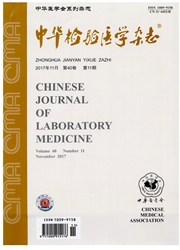

 中文摘要:
中文摘要:
目的:建立基于实时荧光定量PCR(quantitative real-time polymerase chain reaction,RT-q PCR)检测血清循环长链非编码RNA(long non-coding RNA,lnc RNA)HULC的方法,应用该技术检测胃癌、胃息肉患者及正常人血清HULC的表达水平,探讨血清HULC检测在胃癌辅助诊断中的价值。方法:采集经病理确诊的110例初诊胃癌患者、30例胃息肉患者的血清标本,与110例正常人血清标本进行对比,采用RT-q PCR方法检测HULC的相对表达量。结果:RT-q PCR方法检测循环HULC稳定可靠、线性良好、批内变异系数为2.89%、批间变异系数为4.85%。初诊胃癌患者血清HULC表达水平为2.423±0.326,显著高于胃息肉组的1.105±0.102和正常对照组的0.901±0.068,差异均有统计学意义(P均〈0.01),而胃息肉组和正常对照组之间差异无统计学意义(P〉0.05)。以血清HULC相对表达量1.4525作为诊断初诊胃癌患者和正常对照者的临界值,其ROC曲线下面积为0.888(95%CI 0.843~0.934),明显高于CEA 0.694(95%CI 0.621~0.737)和CA72-4 0.514(95%CI 0.433~0.595)。结论 :实时荧光定量PCR是一种简便、特异性好的检测循环HULC的方法,检测血清中循环HULC浓度对胃癌早期辅助诊断有一定的价值。
 英文摘要:
英文摘要:
Objective:To establish a method by using quantitative real-time PCR(RT-q PCR) for detecting circulating long non-coding RNA HULC and investigate HULC expression in patients with benign gastric tumors and normal controls, as to well as explore its clinical significance of early complementary diagnosis of gastric cancer(GC). Methods:Serum samples were collected at random from 100 primary cases, 30 patients with gastric polyps and 110 age-matched normal controls were collected during the same period from the Physical Examination Center of the same hospital. Serum HULC expression levels were detected by RT-q PCR. Results:The RT-q PCR based assay was a reliable method to detect circulating HULC, which also had good linearity. The intra-and Inter-assay coefficients of variations were 2.89% and 4.85%.The levels of serum HULC in GC patients were 2.423±0.326, which was significantly higher than that of patients with gastric polyps(1.105±0.102) and normal controls(0.901±0.068)(P〈0.01). There was no statistically significant difference between gastric polyps and normal controls(P〉0.05). The area under the ROC curve(AUC) of HULC was up to 0.888(95% CI0.843 ~0.934), which was higher than that of CEA(0.694, 95% CI 0.621 ~0.737) and CA72-4(0.514, 95% CI 0.433 ~0.595). Conclusions:The method of RT-q PCR can detect circulating HULC rapidly and specificity. Serum HULC concentrations may be valuable in early complementary diagnosis of GC.
 同期刊论文项目
同期刊论文项目
 同项目期刊论文
同项目期刊论文
 期刊信息
期刊信息
